Evaluating Supply Chain Management in the Global Dairy Industry
VerifiedAdded on 2023/06/08
|14
|4634
|423
Report
AI Summary
This report provides a comprehensive analysis of global supply chain management within the dairy industry. It begins by evaluating the positive and negative attributes of supply chain activities in this sector, considering factors such as health consciousness driving demand and challenges like temperature-related wastage. The report identifies gaps between the evaluation and implementation of supply chain improvements, focusing on supplier relationships, fast-changing markets, and quality compliance. It employs gap analysis, including SWOT and Nadler-Tushman models, to bridge these gaps. Furthermore, the report delves into multidimensional global supply chain issues, such as globalization, inventory management, product quality, planning, risk management, and shipment delays. The analysis underscores the importance of coordination, information sharing, and hygiene practices for success in the dairy industry's supply chain, while also addressing challenges like poor cattle health and inadequate marketing facilities. The report concludes that gap analysis is a crucial tool for identifying and addressing discrepancies between the evaluation and implementation of supply chain strategies.
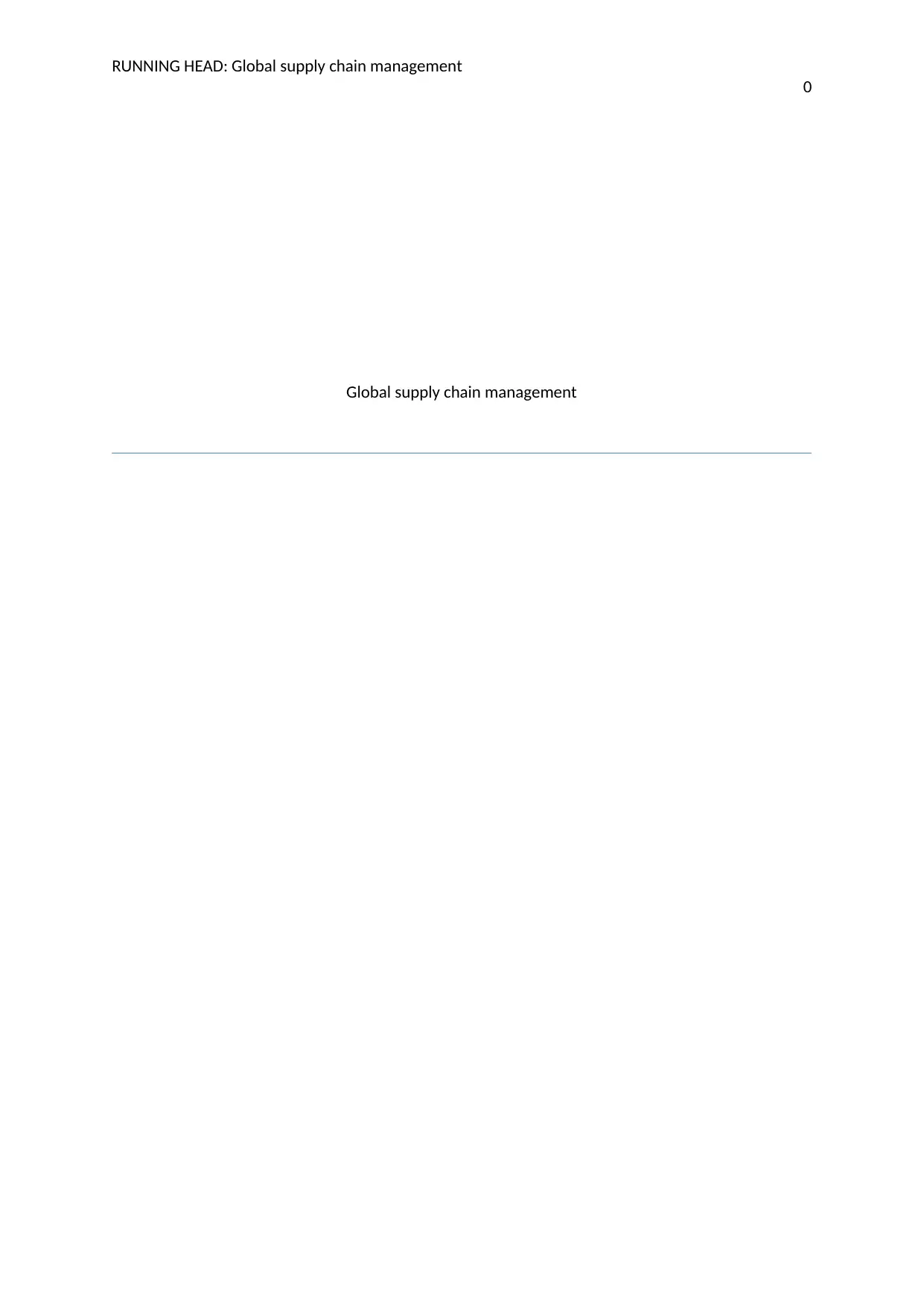
RUNNING HEAD: Global supply chain management
0
Global supply chain management
0
Global supply chain management
Paraphrase This Document
Need a fresh take? Get an instant paraphrase of this document with our AI Paraphraser
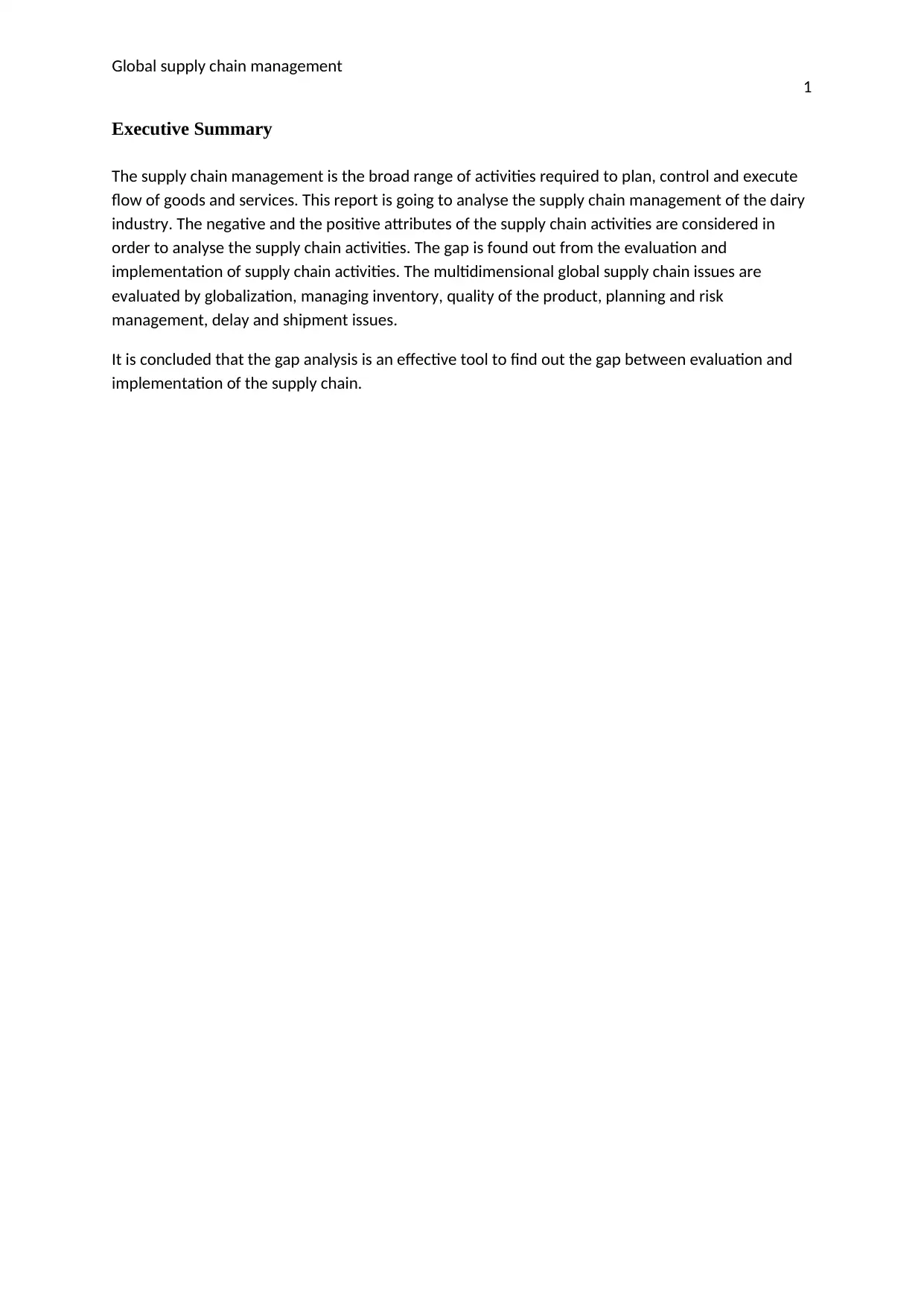
Global supply chain management
1
Executive Summary
The supply chain management is the broad range of activities required to plan, control and execute
flow of goods and services. This report is going to analyse the supply chain management of the dairy
industry. The negative and the positive attributes of the supply chain activities are considered in
order to analyse the supply chain activities. The gap is found out from the evaluation and
implementation of supply chain activities. The multidimensional global supply chain issues are
evaluated by globalization, managing inventory, quality of the product, planning and risk
management, delay and shipment issues.
It is concluded that the gap analysis is an effective tool to find out the gap between evaluation and
implementation of the supply chain.
1
Executive Summary
The supply chain management is the broad range of activities required to plan, control and execute
flow of goods and services. This report is going to analyse the supply chain management of the dairy
industry. The negative and the positive attributes of the supply chain activities are considered in
order to analyse the supply chain activities. The gap is found out from the evaluation and
implementation of supply chain activities. The multidimensional global supply chain issues are
evaluated by globalization, managing inventory, quality of the product, planning and risk
management, delay and shipment issues.
It is concluded that the gap analysis is an effective tool to find out the gap between evaluation and
implementation of the supply chain.
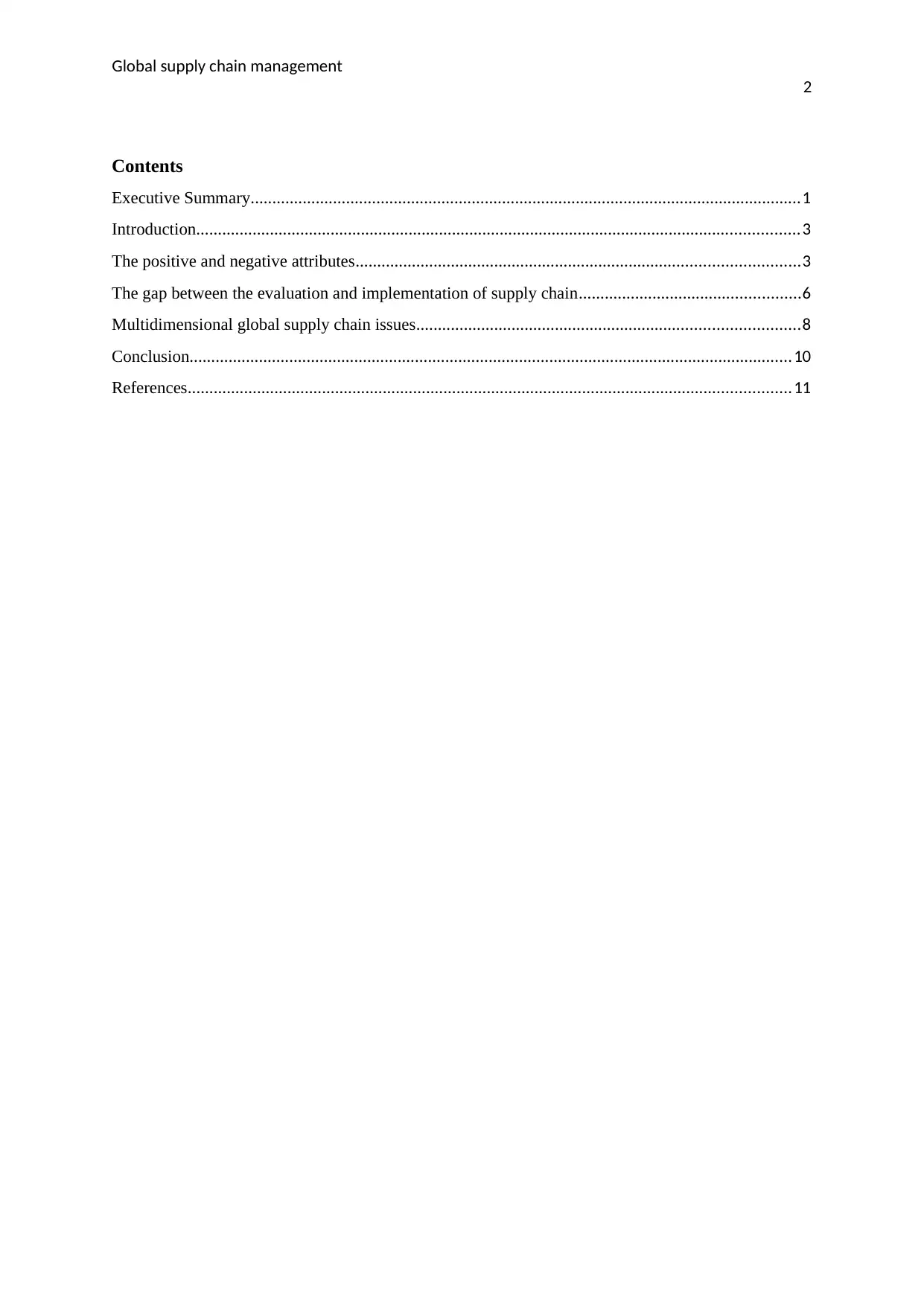
Global supply chain management
2
Contents
Executive Summary...............................................................................................................................1
Introduction...........................................................................................................................................3
The positive and negative attributes......................................................................................................3
The gap between the evaluation and implementation of supply chain...................................................6
Multidimensional global supply chain issues........................................................................................8
Conclusion...........................................................................................................................................10
References...........................................................................................................................................11
2
Contents
Executive Summary...............................................................................................................................1
Introduction...........................................................................................................................................3
The positive and negative attributes......................................................................................................3
The gap between the evaluation and implementation of supply chain...................................................6
Multidimensional global supply chain issues........................................................................................8
Conclusion...........................................................................................................................................10
References...........................................................................................................................................11
⊘ This is a preview!⊘
Do you want full access?
Subscribe today to unlock all pages.

Trusted by 1+ million students worldwide
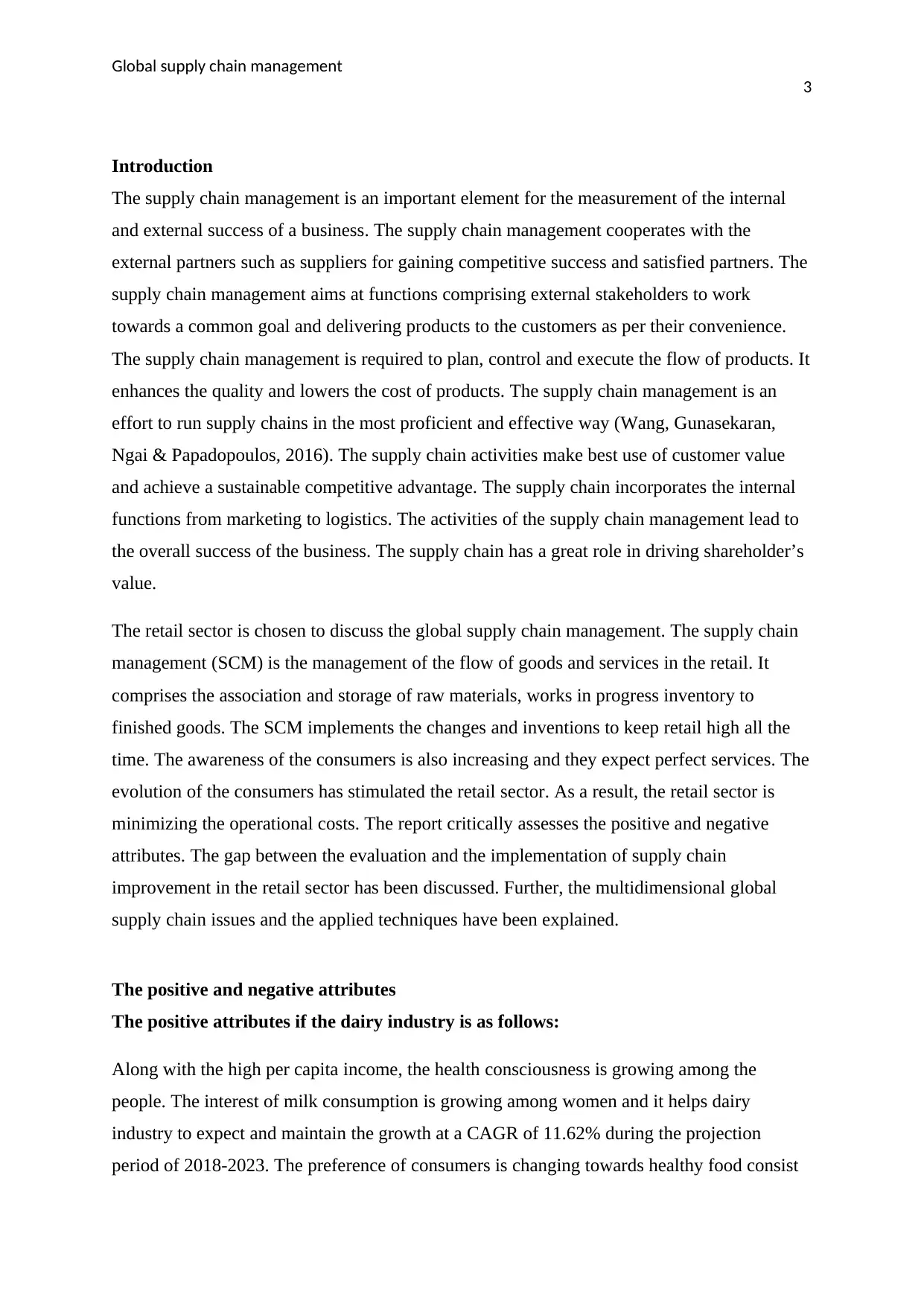
Global supply chain management
3
Introduction
The supply chain management is an important element for the measurement of the internal
and external success of a business. The supply chain management cooperates with the
external partners such as suppliers for gaining competitive success and satisfied partners. The
supply chain management aims at functions comprising external stakeholders to work
towards a common goal and delivering products to the customers as per their convenience.
The supply chain management is required to plan, control and execute the flow of products. It
enhances the quality and lowers the cost of products. The supply chain management is an
effort to run supply chains in the most proficient and effective way (Wang, Gunasekaran,
Ngai & Papadopoulos, 2016). The supply chain activities make best use of customer value
and achieve a sustainable competitive advantage. The supply chain incorporates the internal
functions from marketing to logistics. The activities of the supply chain management lead to
the overall success of the business. The supply chain has a great role in driving shareholder’s
value.
The retail sector is chosen to discuss the global supply chain management. The supply chain
management (SCM) is the management of the flow of goods and services in the retail. It
comprises the association and storage of raw materials, works in progress inventory to
finished goods. The SCM implements the changes and inventions to keep retail high all the
time. The awareness of the consumers is also increasing and they expect perfect services. The
evolution of the consumers has stimulated the retail sector. As a result, the retail sector is
minimizing the operational costs. The report critically assesses the positive and negative
attributes. The gap between the evaluation and the implementation of supply chain
improvement in the retail sector has been discussed. Further, the multidimensional global
supply chain issues and the applied techniques have been explained.
The positive and negative attributes
The positive attributes if the dairy industry is as follows:
Along with the high per capita income, the health consciousness is growing among the
people. The interest of milk consumption is growing among women and it helps dairy
industry to expect and maintain the growth at a CAGR of 11.62% during the projection
period of 2018-2023. The preference of consumers is changing towards healthy food consist
3
Introduction
The supply chain management is an important element for the measurement of the internal
and external success of a business. The supply chain management cooperates with the
external partners such as suppliers for gaining competitive success and satisfied partners. The
supply chain management aims at functions comprising external stakeholders to work
towards a common goal and delivering products to the customers as per their convenience.
The supply chain management is required to plan, control and execute the flow of products. It
enhances the quality and lowers the cost of products. The supply chain management is an
effort to run supply chains in the most proficient and effective way (Wang, Gunasekaran,
Ngai & Papadopoulos, 2016). The supply chain activities make best use of customer value
and achieve a sustainable competitive advantage. The supply chain incorporates the internal
functions from marketing to logistics. The activities of the supply chain management lead to
the overall success of the business. The supply chain has a great role in driving shareholder’s
value.
The retail sector is chosen to discuss the global supply chain management. The supply chain
management (SCM) is the management of the flow of goods and services in the retail. It
comprises the association and storage of raw materials, works in progress inventory to
finished goods. The SCM implements the changes and inventions to keep retail high all the
time. The awareness of the consumers is also increasing and they expect perfect services. The
evolution of the consumers has stimulated the retail sector. As a result, the retail sector is
minimizing the operational costs. The report critically assesses the positive and negative
attributes. The gap between the evaluation and the implementation of supply chain
improvement in the retail sector has been discussed. Further, the multidimensional global
supply chain issues and the applied techniques have been explained.
The positive and negative attributes
The positive attributes if the dairy industry is as follows:
Along with the high per capita income, the health consciousness is growing among the
people. The interest of milk consumption is growing among women and it helps dairy
industry to expect and maintain the growth at a CAGR of 11.62% during the projection
period of 2018-2023. The preference of consumers is changing towards healthy food consist
Paraphrase This Document
Need a fresh take? Get an instant paraphrase of this document with our AI Paraphraser
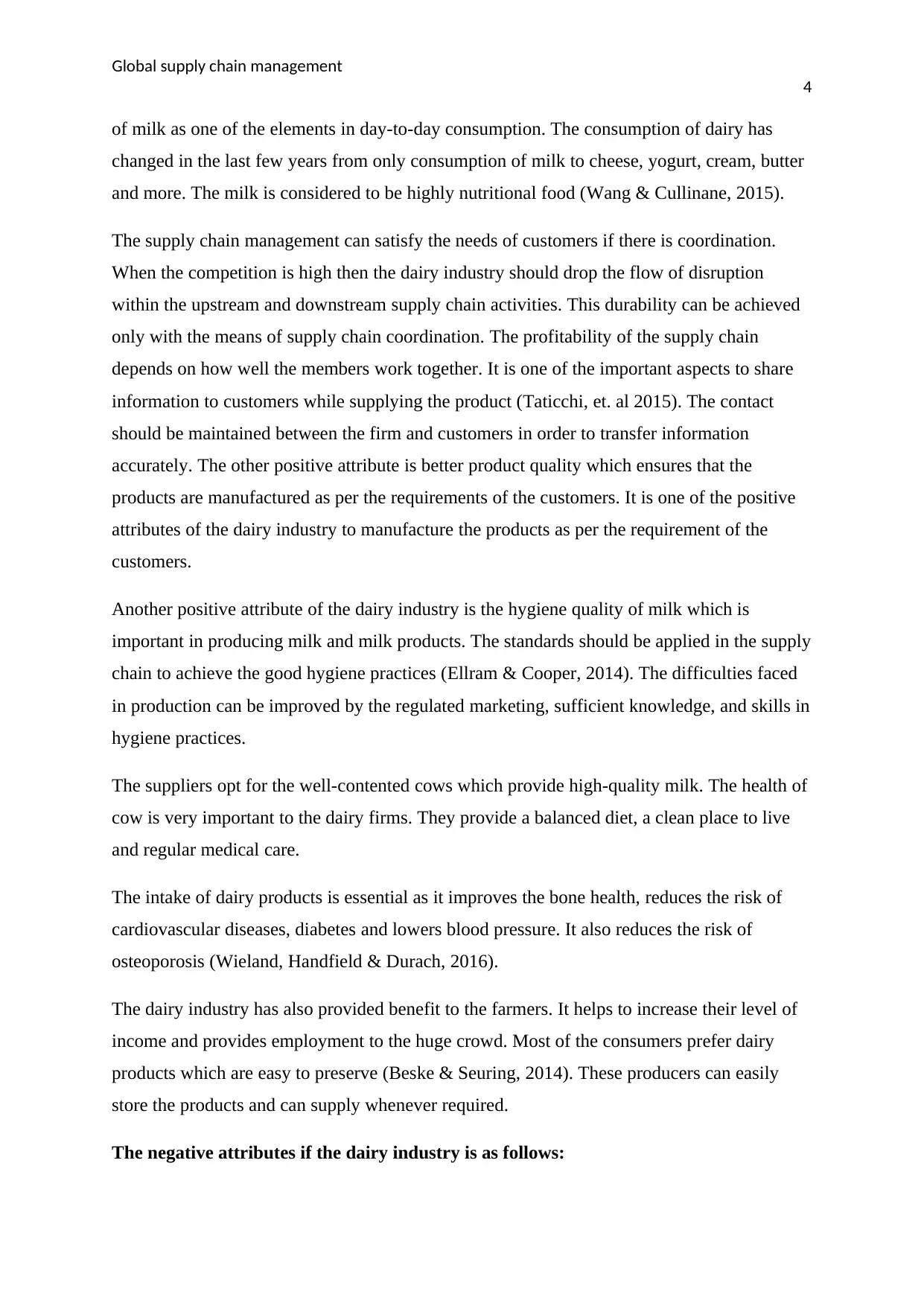
Global supply chain management
4
of milk as one of the elements in day-to-day consumption. The consumption of dairy has
changed in the last few years from only consumption of milk to cheese, yogurt, cream, butter
and more. The milk is considered to be highly nutritional food (Wang & Cullinane, 2015).
The supply chain management can satisfy the needs of customers if there is coordination.
When the competition is high then the dairy industry should drop the flow of disruption
within the upstream and downstream supply chain activities. This durability can be achieved
only with the means of supply chain coordination. The profitability of the supply chain
depends on how well the members work together. It is one of the important aspects to share
information to customers while supplying the product (Taticchi, et. al 2015). The contact
should be maintained between the firm and customers in order to transfer information
accurately. The other positive attribute is better product quality which ensures that the
products are manufactured as per the requirements of the customers. It is one of the positive
attributes of the dairy industry to manufacture the products as per the requirement of the
customers.
Another positive attribute of the dairy industry is the hygiene quality of milk which is
important in producing milk and milk products. The standards should be applied in the supply
chain to achieve the good hygiene practices (Ellram & Cooper, 2014). The difficulties faced
in production can be improved by the regulated marketing, sufficient knowledge, and skills in
hygiene practices.
The suppliers opt for the well-contented cows which provide high-quality milk. The health of
cow is very important to the dairy firms. They provide a balanced diet, a clean place to live
and regular medical care.
The intake of dairy products is essential as it improves the bone health, reduces the risk of
cardiovascular diseases, diabetes and lowers blood pressure. It also reduces the risk of
osteoporosis (Wieland, Handfield & Durach, 2016).
The dairy industry has also provided benefit to the farmers. It helps to increase their level of
income and provides employment to the huge crowd. Most of the consumers prefer dairy
products which are easy to preserve (Beske & Seuring, 2014). These producers can easily
store the products and can supply whenever required.
The negative attributes if the dairy industry is as follows:
4
of milk as one of the elements in day-to-day consumption. The consumption of dairy has
changed in the last few years from only consumption of milk to cheese, yogurt, cream, butter
and more. The milk is considered to be highly nutritional food (Wang & Cullinane, 2015).
The supply chain management can satisfy the needs of customers if there is coordination.
When the competition is high then the dairy industry should drop the flow of disruption
within the upstream and downstream supply chain activities. This durability can be achieved
only with the means of supply chain coordination. The profitability of the supply chain
depends on how well the members work together. It is one of the important aspects to share
information to customers while supplying the product (Taticchi, et. al 2015). The contact
should be maintained between the firm and customers in order to transfer information
accurately. The other positive attribute is better product quality which ensures that the
products are manufactured as per the requirements of the customers. It is one of the positive
attributes of the dairy industry to manufacture the products as per the requirement of the
customers.
Another positive attribute of the dairy industry is the hygiene quality of milk which is
important in producing milk and milk products. The standards should be applied in the supply
chain to achieve the good hygiene practices (Ellram & Cooper, 2014). The difficulties faced
in production can be improved by the regulated marketing, sufficient knowledge, and skills in
hygiene practices.
The suppliers opt for the well-contented cows which provide high-quality milk. The health of
cow is very important to the dairy firms. They provide a balanced diet, a clean place to live
and regular medical care.
The intake of dairy products is essential as it improves the bone health, reduces the risk of
cardiovascular diseases, diabetes and lowers blood pressure. It also reduces the risk of
osteoporosis (Wieland, Handfield & Durach, 2016).
The dairy industry has also provided benefit to the farmers. It helps to increase their level of
income and provides employment to the huge crowd. Most of the consumers prefer dairy
products which are easy to preserve (Beske & Seuring, 2014). These producers can easily
store the products and can supply whenever required.
The negative attributes if the dairy industry is as follows:
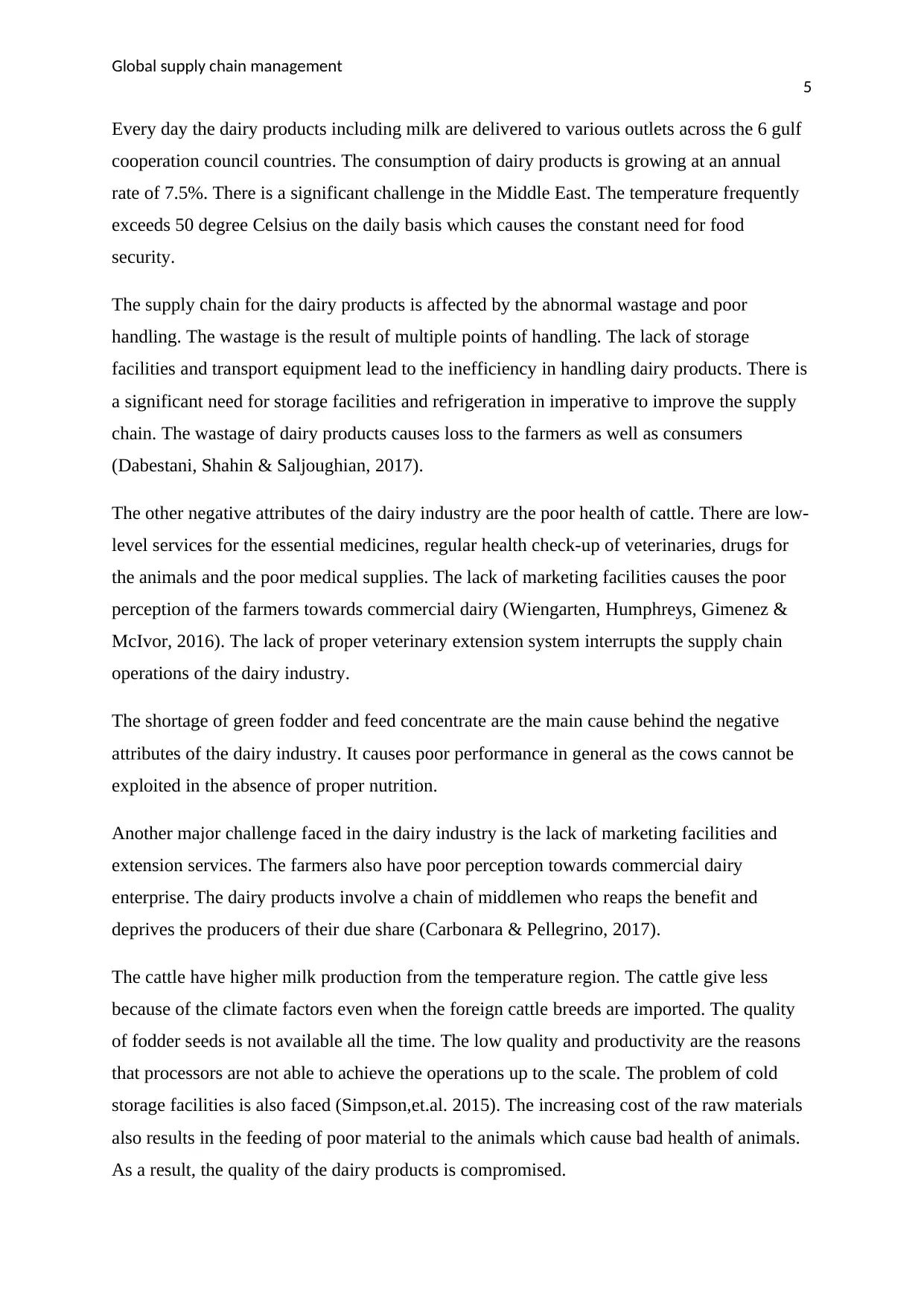
Global supply chain management
5
Every day the dairy products including milk are delivered to various outlets across the 6 gulf
cooperation council countries. The consumption of dairy products is growing at an annual
rate of 7.5%. There is a significant challenge in the Middle East. The temperature frequently
exceeds 50 degree Celsius on the daily basis which causes the constant need for food
security.
The supply chain for the dairy products is affected by the abnormal wastage and poor
handling. The wastage is the result of multiple points of handling. The lack of storage
facilities and transport equipment lead to the inefficiency in handling dairy products. There is
a significant need for storage facilities and refrigeration in imperative to improve the supply
chain. The wastage of dairy products causes loss to the farmers as well as consumers
(Dabestani, Shahin & Saljoughian, 2017).
The other negative attributes of the dairy industry are the poor health of cattle. There are low-
level services for the essential medicines, regular health check-up of veterinaries, drugs for
the animals and the poor medical supplies. The lack of marketing facilities causes the poor
perception of the farmers towards commercial dairy (Wiengarten, Humphreys, Gimenez &
McIvor, 2016). The lack of proper veterinary extension system interrupts the supply chain
operations of the dairy industry.
The shortage of green fodder and feed concentrate are the main cause behind the negative
attributes of the dairy industry. It causes poor performance in general as the cows cannot be
exploited in the absence of proper nutrition.
Another major challenge faced in the dairy industry is the lack of marketing facilities and
extension services. The farmers also have poor perception towards commercial dairy
enterprise. The dairy products involve a chain of middlemen who reaps the benefit and
deprives the producers of their due share (Carbonara & Pellegrino, 2017).
The cattle have higher milk production from the temperature region. The cattle give less
because of the climate factors even when the foreign cattle breeds are imported. The quality
of fodder seeds is not available all the time. The low quality and productivity are the reasons
that processors are not able to achieve the operations up to the scale. The problem of cold
storage facilities is also faced (Simpson,et.al. 2015). The increasing cost of the raw materials
also results in the feeding of poor material to the animals which cause bad health of animals.
As a result, the quality of the dairy products is compromised.
5
Every day the dairy products including milk are delivered to various outlets across the 6 gulf
cooperation council countries. The consumption of dairy products is growing at an annual
rate of 7.5%. There is a significant challenge in the Middle East. The temperature frequently
exceeds 50 degree Celsius on the daily basis which causes the constant need for food
security.
The supply chain for the dairy products is affected by the abnormal wastage and poor
handling. The wastage is the result of multiple points of handling. The lack of storage
facilities and transport equipment lead to the inefficiency in handling dairy products. There is
a significant need for storage facilities and refrigeration in imperative to improve the supply
chain. The wastage of dairy products causes loss to the farmers as well as consumers
(Dabestani, Shahin & Saljoughian, 2017).
The other negative attributes of the dairy industry are the poor health of cattle. There are low-
level services for the essential medicines, regular health check-up of veterinaries, drugs for
the animals and the poor medical supplies. The lack of marketing facilities causes the poor
perception of the farmers towards commercial dairy (Wiengarten, Humphreys, Gimenez &
McIvor, 2016). The lack of proper veterinary extension system interrupts the supply chain
operations of the dairy industry.
The shortage of green fodder and feed concentrate are the main cause behind the negative
attributes of the dairy industry. It causes poor performance in general as the cows cannot be
exploited in the absence of proper nutrition.
Another major challenge faced in the dairy industry is the lack of marketing facilities and
extension services. The farmers also have poor perception towards commercial dairy
enterprise. The dairy products involve a chain of middlemen who reaps the benefit and
deprives the producers of their due share (Carbonara & Pellegrino, 2017).
The cattle have higher milk production from the temperature region. The cattle give less
because of the climate factors even when the foreign cattle breeds are imported. The quality
of fodder seeds is not available all the time. The low quality and productivity are the reasons
that processors are not able to achieve the operations up to the scale. The problem of cold
storage facilities is also faced (Simpson,et.al. 2015). The increasing cost of the raw materials
also results in the feeding of poor material to the animals which cause bad health of animals.
As a result, the quality of the dairy products is compromised.
⊘ This is a preview!⊘
Do you want full access?
Subscribe today to unlock all pages.

Trusted by 1+ million students worldwide
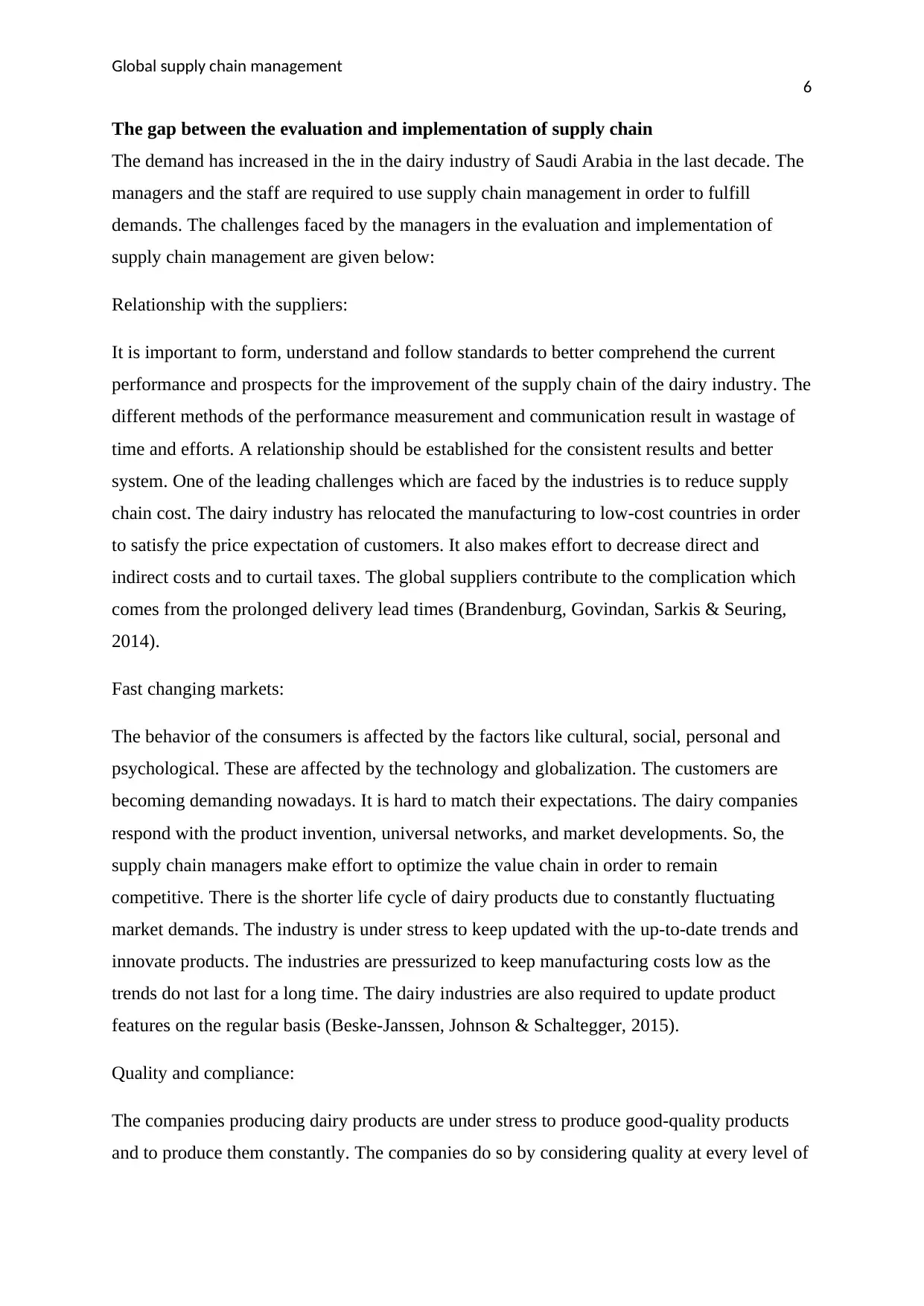
Global supply chain management
6
The gap between the evaluation and implementation of supply chain
The demand has increased in the in the dairy industry of Saudi Arabia in the last decade. The
managers and the staff are required to use supply chain management in order to fulfill
demands. The challenges faced by the managers in the evaluation and implementation of
supply chain management are given below:
Relationship with the suppliers:
It is important to form, understand and follow standards to better comprehend the current
performance and prospects for the improvement of the supply chain of the dairy industry. The
different methods of the performance measurement and communication result in wastage of
time and efforts. A relationship should be established for the consistent results and better
system. One of the leading challenges which are faced by the industries is to reduce supply
chain cost. The dairy industry has relocated the manufacturing to low-cost countries in order
to satisfy the price expectation of customers. It also makes effort to decrease direct and
indirect costs and to curtail taxes. The global suppliers contribute to the complication which
comes from the prolonged delivery lead times (Brandenburg, Govindan, Sarkis & Seuring,
2014).
Fast changing markets:
The behavior of the consumers is affected by the factors like cultural, social, personal and
psychological. These are affected by the technology and globalization. The customers are
becoming demanding nowadays. It is hard to match their expectations. The dairy companies
respond with the product invention, universal networks, and market developments. So, the
supply chain managers make effort to optimize the value chain in order to remain
competitive. There is the shorter life cycle of dairy products due to constantly fluctuating
market demands. The industry is under stress to keep updated with the up-to-date trends and
innovate products. The industries are pressurized to keep manufacturing costs low as the
trends do not last for a long time. The dairy industries are also required to update product
features on the regular basis (Beske-Janssen, Johnson & Schaltegger, 2015).
Quality and compliance:
The companies producing dairy products are under stress to produce good-quality products
and to produce them constantly. The companies do so by considering quality at every level of
6
The gap between the evaluation and implementation of supply chain
The demand has increased in the in the dairy industry of Saudi Arabia in the last decade. The
managers and the staff are required to use supply chain management in order to fulfill
demands. The challenges faced by the managers in the evaluation and implementation of
supply chain management are given below:
Relationship with the suppliers:
It is important to form, understand and follow standards to better comprehend the current
performance and prospects for the improvement of the supply chain of the dairy industry. The
different methods of the performance measurement and communication result in wastage of
time and efforts. A relationship should be established for the consistent results and better
system. One of the leading challenges which are faced by the industries is to reduce supply
chain cost. The dairy industry has relocated the manufacturing to low-cost countries in order
to satisfy the price expectation of customers. It also makes effort to decrease direct and
indirect costs and to curtail taxes. The global suppliers contribute to the complication which
comes from the prolonged delivery lead times (Brandenburg, Govindan, Sarkis & Seuring,
2014).
Fast changing markets:
The behavior of the consumers is affected by the factors like cultural, social, personal and
psychological. These are affected by the technology and globalization. The customers are
becoming demanding nowadays. It is hard to match their expectations. The dairy companies
respond with the product invention, universal networks, and market developments. So, the
supply chain managers make effort to optimize the value chain in order to remain
competitive. There is the shorter life cycle of dairy products due to constantly fluctuating
market demands. The industry is under stress to keep updated with the up-to-date trends and
innovate products. The industries are pressurized to keep manufacturing costs low as the
trends do not last for a long time. The dairy industries are also required to update product
features on the regular basis (Beske-Janssen, Johnson & Schaltegger, 2015).
Quality and compliance:
The companies producing dairy products are under stress to produce good-quality products
and to produce them constantly. The companies do so by considering quality at every level of
Paraphrase This Document
Need a fresh take? Get an instant paraphrase of this document with our AI Paraphraser
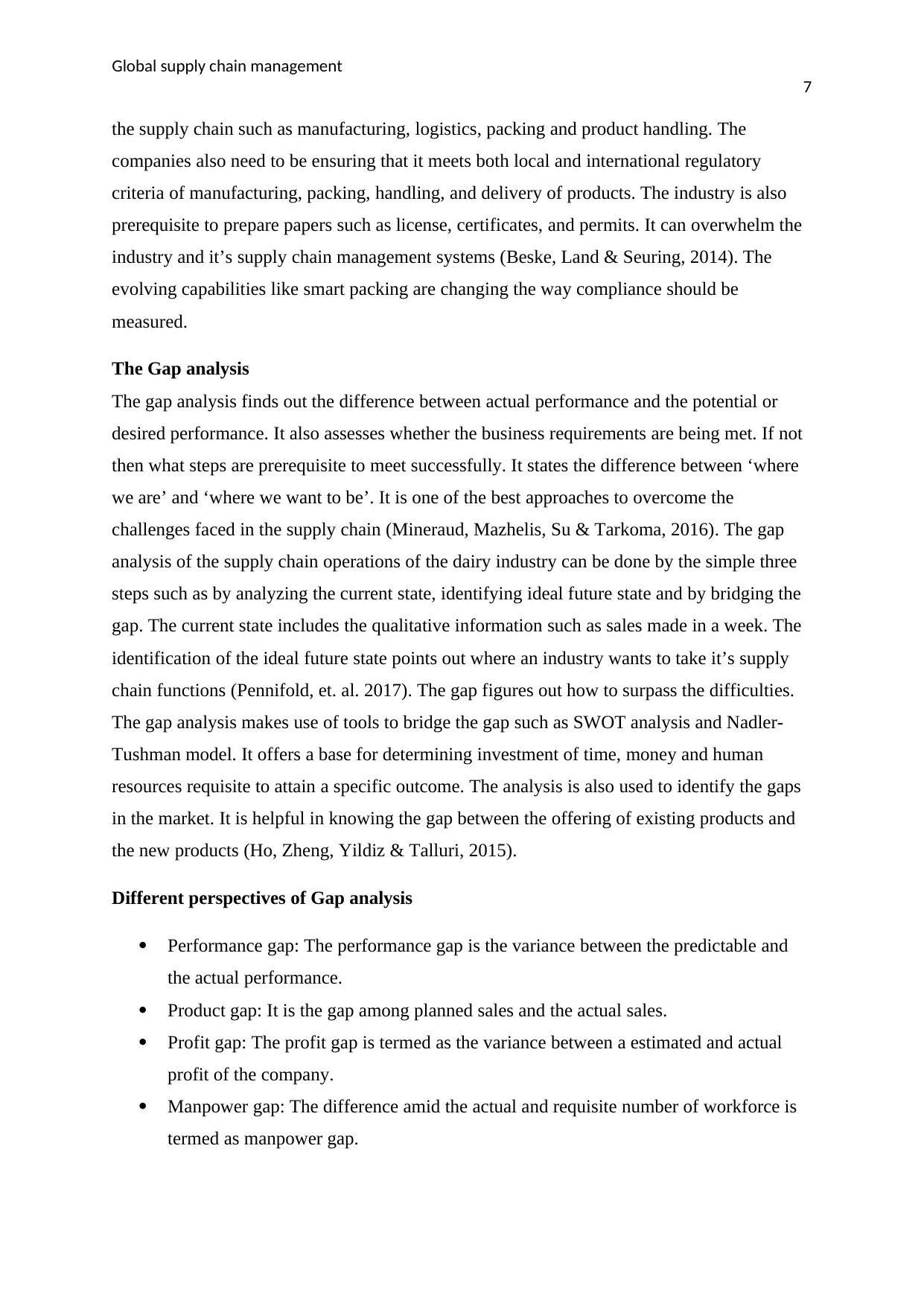
Global supply chain management
7
the supply chain such as manufacturing, logistics, packing and product handling. The
companies also need to be ensuring that it meets both local and international regulatory
criteria of manufacturing, packing, handling, and delivery of products. The industry is also
prerequisite to prepare papers such as license, certificates, and permits. It can overwhelm the
industry and it’s supply chain management systems (Beske, Land & Seuring, 2014). The
evolving capabilities like smart packing are changing the way compliance should be
measured.
The Gap analysis
The gap analysis finds out the difference between actual performance and the potential or
desired performance. It also assesses whether the business requirements are being met. If not
then what steps are prerequisite to meet successfully. It states the difference between ‘where
we are’ and ‘where we want to be’. It is one of the best approaches to overcome the
challenges faced in the supply chain (Mineraud, Mazhelis, Su & Tarkoma, 2016). The gap
analysis of the supply chain operations of the dairy industry can be done by the simple three
steps such as by analyzing the current state, identifying ideal future state and by bridging the
gap. The current state includes the qualitative information such as sales made in a week. The
identification of the ideal future state points out where an industry wants to take it’s supply
chain functions (Pennifold, et. al. 2017). The gap figures out how to surpass the difficulties.
The gap analysis makes use of tools to bridge the gap such as SWOT analysis and Nadler-
Tushman model. It offers a base for determining investment of time, money and human
resources requisite to attain a specific outcome. The analysis is also used to identify the gaps
in the market. It is helpful in knowing the gap between the offering of existing products and
the new products (Ho, Zheng, Yildiz & Talluri, 2015).
Different perspectives of Gap analysis
Performance gap: The performance gap is the variance between the predictable and
the actual performance.
Product gap: It is the gap among planned sales and the actual sales.
Profit gap: The profit gap is termed as the variance between a estimated and actual
profit of the company.
Manpower gap: The difference amid the actual and requisite number of workforce is
termed as manpower gap.
7
the supply chain such as manufacturing, logistics, packing and product handling. The
companies also need to be ensuring that it meets both local and international regulatory
criteria of manufacturing, packing, handling, and delivery of products. The industry is also
prerequisite to prepare papers such as license, certificates, and permits. It can overwhelm the
industry and it’s supply chain management systems (Beske, Land & Seuring, 2014). The
evolving capabilities like smart packing are changing the way compliance should be
measured.
The Gap analysis
The gap analysis finds out the difference between actual performance and the potential or
desired performance. It also assesses whether the business requirements are being met. If not
then what steps are prerequisite to meet successfully. It states the difference between ‘where
we are’ and ‘where we want to be’. It is one of the best approaches to overcome the
challenges faced in the supply chain (Mineraud, Mazhelis, Su & Tarkoma, 2016). The gap
analysis of the supply chain operations of the dairy industry can be done by the simple three
steps such as by analyzing the current state, identifying ideal future state and by bridging the
gap. The current state includes the qualitative information such as sales made in a week. The
identification of the ideal future state points out where an industry wants to take it’s supply
chain functions (Pennifold, et. al. 2017). The gap figures out how to surpass the difficulties.
The gap analysis makes use of tools to bridge the gap such as SWOT analysis and Nadler-
Tushman model. It offers a base for determining investment of time, money and human
resources requisite to attain a specific outcome. The analysis is also used to identify the gaps
in the market. It is helpful in knowing the gap between the offering of existing products and
the new products (Ho, Zheng, Yildiz & Talluri, 2015).
Different perspectives of Gap analysis
Performance gap: The performance gap is the variance between the predictable and
the actual performance.
Product gap: It is the gap among planned sales and the actual sales.
Profit gap: The profit gap is termed as the variance between a estimated and actual
profit of the company.
Manpower gap: The difference amid the actual and requisite number of workforce is
termed as manpower gap.
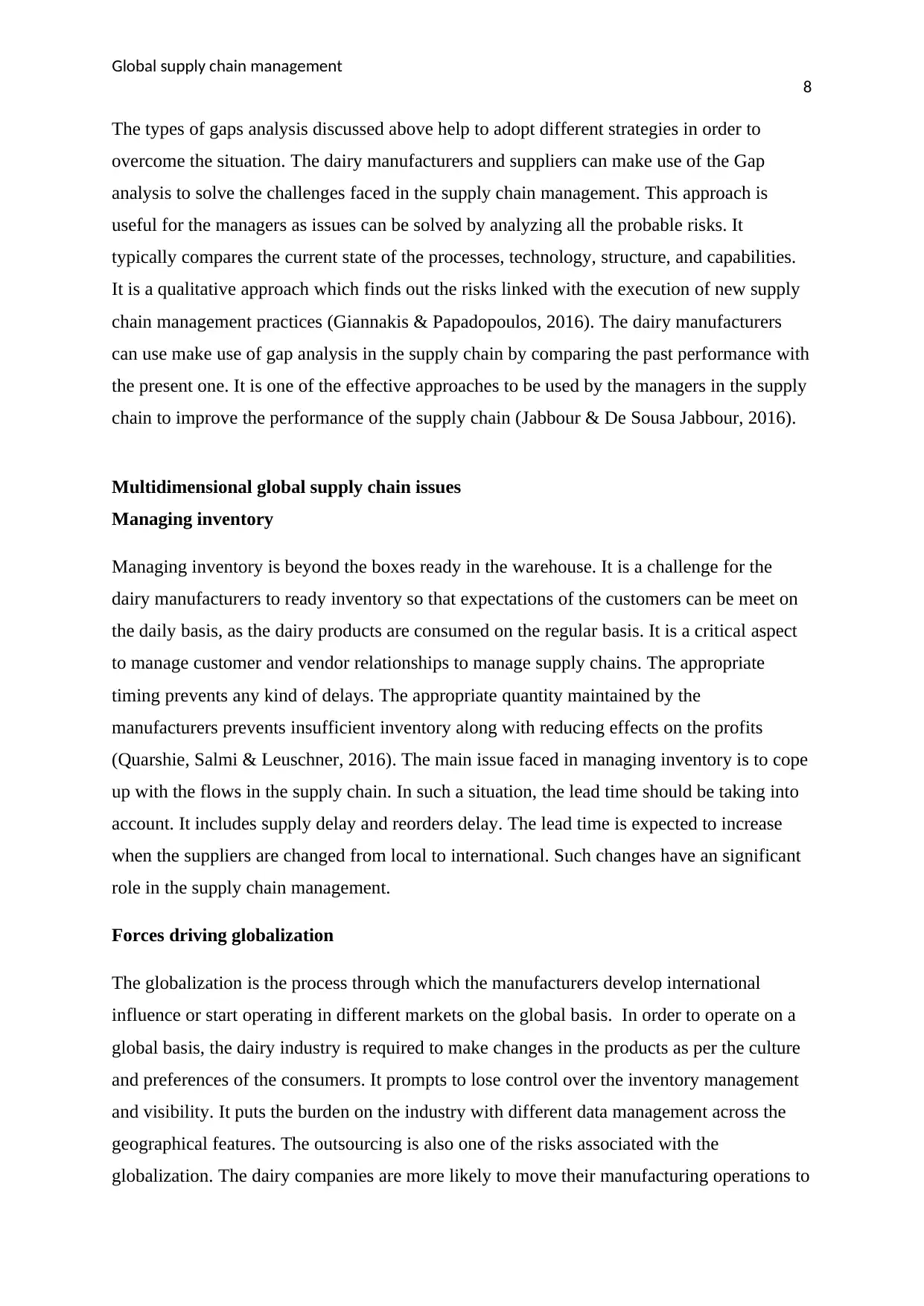
Global supply chain management
8
The types of gaps analysis discussed above help to adopt different strategies in order to
overcome the situation. The dairy manufacturers and suppliers can make use of the Gap
analysis to solve the challenges faced in the supply chain management. This approach is
useful for the managers as issues can be solved by analyzing all the probable risks. It
typically compares the current state of the processes, technology, structure, and capabilities.
It is a qualitative approach which finds out the risks linked with the execution of new supply
chain management practices (Giannakis & Papadopoulos, 2016). The dairy manufacturers
can use make use of gap analysis in the supply chain by comparing the past performance with
the present one. It is one of the effective approaches to be used by the managers in the supply
chain to improve the performance of the supply chain (Jabbour & De Sousa Jabbour, 2016).
Multidimensional global supply chain issues
Managing inventory
Managing inventory is beyond the boxes ready in the warehouse. It is a challenge for the
dairy manufacturers to ready inventory so that expectations of the customers can be meet on
the daily basis, as the dairy products are consumed on the regular basis. It is a critical aspect
to manage customer and vendor relationships to manage supply chains. The appropriate
timing prevents any kind of delays. The appropriate quantity maintained by the
manufacturers prevents insufficient inventory along with reducing effects on the profits
(Quarshie, Salmi & Leuschner, 2016). The main issue faced in managing inventory is to cope
up with the flows in the supply chain. In such a situation, the lead time should be taking into
account. It includes supply delay and reorders delay. The lead time is expected to increase
when the suppliers are changed from local to international. Such changes have an significant
role in the supply chain management.
Forces driving globalization
The globalization is the process through which the manufacturers develop international
influence or start operating in different markets on the global basis. In order to operate on a
global basis, the dairy industry is required to make changes in the products as per the culture
and preferences of the consumers. It prompts to lose control over the inventory management
and visibility. It puts the burden on the industry with different data management across the
geographical features. The outsourcing is also one of the risks associated with the
globalization. The dairy companies are more likely to move their manufacturing operations to
8
The types of gaps analysis discussed above help to adopt different strategies in order to
overcome the situation. The dairy manufacturers and suppliers can make use of the Gap
analysis to solve the challenges faced in the supply chain management. This approach is
useful for the managers as issues can be solved by analyzing all the probable risks. It
typically compares the current state of the processes, technology, structure, and capabilities.
It is a qualitative approach which finds out the risks linked with the execution of new supply
chain management practices (Giannakis & Papadopoulos, 2016). The dairy manufacturers
can use make use of gap analysis in the supply chain by comparing the past performance with
the present one. It is one of the effective approaches to be used by the managers in the supply
chain to improve the performance of the supply chain (Jabbour & De Sousa Jabbour, 2016).
Multidimensional global supply chain issues
Managing inventory
Managing inventory is beyond the boxes ready in the warehouse. It is a challenge for the
dairy manufacturers to ready inventory so that expectations of the customers can be meet on
the daily basis, as the dairy products are consumed on the regular basis. It is a critical aspect
to manage customer and vendor relationships to manage supply chains. The appropriate
timing prevents any kind of delays. The appropriate quantity maintained by the
manufacturers prevents insufficient inventory along with reducing effects on the profits
(Quarshie, Salmi & Leuschner, 2016). The main issue faced in managing inventory is to cope
up with the flows in the supply chain. In such a situation, the lead time should be taking into
account. It includes supply delay and reorders delay. The lead time is expected to increase
when the suppliers are changed from local to international. Such changes have an significant
role in the supply chain management.
Forces driving globalization
The globalization is the process through which the manufacturers develop international
influence or start operating in different markets on the global basis. In order to operate on a
global basis, the dairy industry is required to make changes in the products as per the culture
and preferences of the consumers. It prompts to lose control over the inventory management
and visibility. It puts the burden on the industry with different data management across the
geographical features. The outsourcing is also one of the risks associated with the
globalization. The dairy companies are more likely to move their manufacturing operations to
⊘ This is a preview!⊘
Do you want full access?
Subscribe today to unlock all pages.

Trusted by 1+ million students worldwide
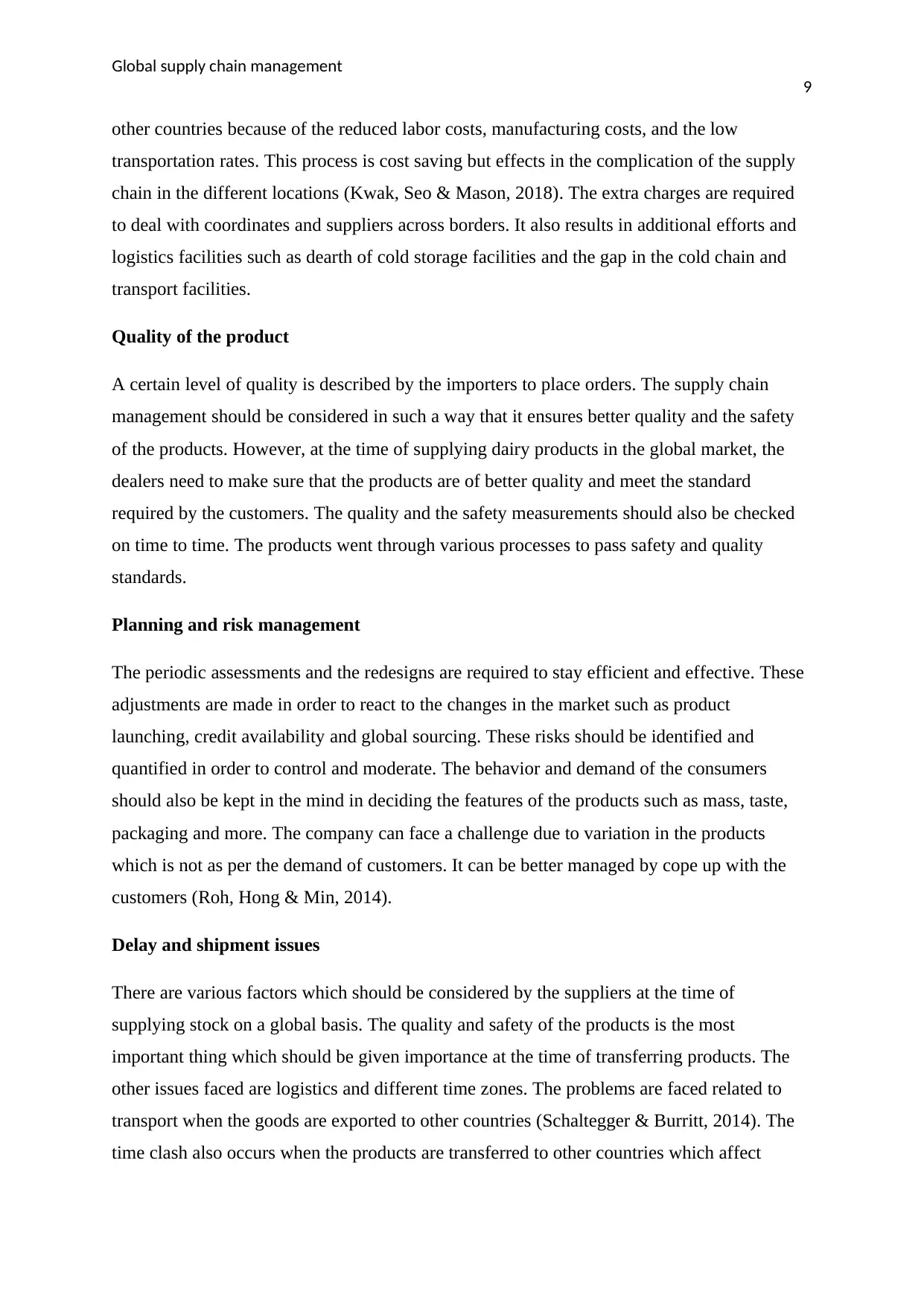
Global supply chain management
9
other countries because of the reduced labor costs, manufacturing costs, and the low
transportation rates. This process is cost saving but effects in the complication of the supply
chain in the different locations (Kwak, Seo & Mason, 2018). The extra charges are required
to deal with coordinates and suppliers across borders. It also results in additional efforts and
logistics facilities such as dearth of cold storage facilities and the gap in the cold chain and
transport facilities.
Quality of the product
A certain level of quality is described by the importers to place orders. The supply chain
management should be considered in such a way that it ensures better quality and the safety
of the products. However, at the time of supplying dairy products in the global market, the
dealers need to make sure that the products are of better quality and meet the standard
required by the customers. The quality and the safety measurements should also be checked
on time to time. The products went through various processes to pass safety and quality
standards.
Planning and risk management
The periodic assessments and the redesigns are required to stay efficient and effective. These
adjustments are made in order to react to the changes in the market such as product
launching, credit availability and global sourcing. These risks should be identified and
quantified in order to control and moderate. The behavior and demand of the consumers
should also be kept in the mind in deciding the features of the products such as mass, taste,
packaging and more. The company can face a challenge due to variation in the products
which is not as per the demand of customers. It can be better managed by cope up with the
customers (Roh, Hong & Min, 2014).
Delay and shipment issues
There are various factors which should be considered by the suppliers at the time of
supplying stock on a global basis. The quality and safety of the products is the most
important thing which should be given importance at the time of transferring products. The
other issues faced are logistics and different time zones. The problems are faced related to
transport when the goods are exported to other countries (Schaltegger & Burritt, 2014). The
time clash also occurs when the products are transferred to other countries which affect
9
other countries because of the reduced labor costs, manufacturing costs, and the low
transportation rates. This process is cost saving but effects in the complication of the supply
chain in the different locations (Kwak, Seo & Mason, 2018). The extra charges are required
to deal with coordinates and suppliers across borders. It also results in additional efforts and
logistics facilities such as dearth of cold storage facilities and the gap in the cold chain and
transport facilities.
Quality of the product
A certain level of quality is described by the importers to place orders. The supply chain
management should be considered in such a way that it ensures better quality and the safety
of the products. However, at the time of supplying dairy products in the global market, the
dealers need to make sure that the products are of better quality and meet the standard
required by the customers. The quality and the safety measurements should also be checked
on time to time. The products went through various processes to pass safety and quality
standards.
Planning and risk management
The periodic assessments and the redesigns are required to stay efficient and effective. These
adjustments are made in order to react to the changes in the market such as product
launching, credit availability and global sourcing. These risks should be identified and
quantified in order to control and moderate. The behavior and demand of the consumers
should also be kept in the mind in deciding the features of the products such as mass, taste,
packaging and more. The company can face a challenge due to variation in the products
which is not as per the demand of customers. It can be better managed by cope up with the
customers (Roh, Hong & Min, 2014).
Delay and shipment issues
There are various factors which should be considered by the suppliers at the time of
supplying stock on a global basis. The quality and safety of the products is the most
important thing which should be given importance at the time of transferring products. The
other issues faced are logistics and different time zones. The problems are faced related to
transport when the goods are exported to other countries (Schaltegger & Burritt, 2014). The
time clash also occurs when the products are transferred to other countries which affect
Paraphrase This Document
Need a fresh take? Get an instant paraphrase of this document with our AI Paraphraser
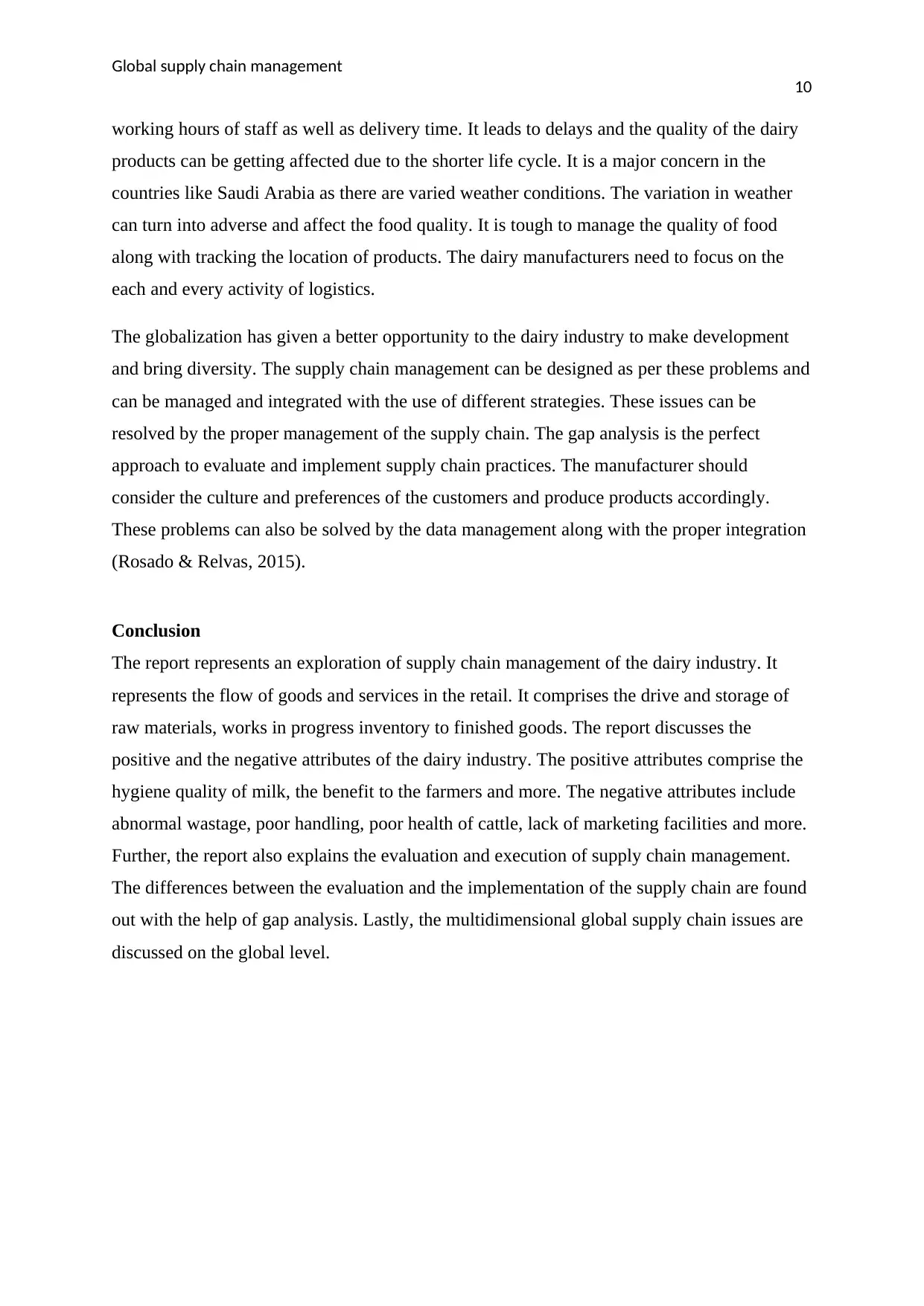
Global supply chain management
10
working hours of staff as well as delivery time. It leads to delays and the quality of the dairy
products can be getting affected due to the shorter life cycle. It is a major concern in the
countries like Saudi Arabia as there are varied weather conditions. The variation in weather
can turn into adverse and affect the food quality. It is tough to manage the quality of food
along with tracking the location of products. The dairy manufacturers need to focus on the
each and every activity of logistics.
The globalization has given a better opportunity to the dairy industry to make development
and bring diversity. The supply chain management can be designed as per these problems and
can be managed and integrated with the use of different strategies. These issues can be
resolved by the proper management of the supply chain. The gap analysis is the perfect
approach to evaluate and implement supply chain practices. The manufacturer should
consider the culture and preferences of the customers and produce products accordingly.
These problems can also be solved by the data management along with the proper integration
(Rosado & Relvas, 2015).
Conclusion
The report represents an exploration of supply chain management of the dairy industry. It
represents the flow of goods and services in the retail. It comprises the drive and storage of
raw materials, works in progress inventory to finished goods. The report discusses the
positive and the negative attributes of the dairy industry. The positive attributes comprise the
hygiene quality of milk, the benefit to the farmers and more. The negative attributes include
abnormal wastage, poor handling, poor health of cattle, lack of marketing facilities and more.
Further, the report also explains the evaluation and execution of supply chain management.
The differences between the evaluation and the implementation of the supply chain are found
out with the help of gap analysis. Lastly, the multidimensional global supply chain issues are
discussed on the global level.
10
working hours of staff as well as delivery time. It leads to delays and the quality of the dairy
products can be getting affected due to the shorter life cycle. It is a major concern in the
countries like Saudi Arabia as there are varied weather conditions. The variation in weather
can turn into adverse and affect the food quality. It is tough to manage the quality of food
along with tracking the location of products. The dairy manufacturers need to focus on the
each and every activity of logistics.
The globalization has given a better opportunity to the dairy industry to make development
and bring diversity. The supply chain management can be designed as per these problems and
can be managed and integrated with the use of different strategies. These issues can be
resolved by the proper management of the supply chain. The gap analysis is the perfect
approach to evaluate and implement supply chain practices. The manufacturer should
consider the culture and preferences of the customers and produce products accordingly.
These problems can also be solved by the data management along with the proper integration
(Rosado & Relvas, 2015).
Conclusion
The report represents an exploration of supply chain management of the dairy industry. It
represents the flow of goods and services in the retail. It comprises the drive and storage of
raw materials, works in progress inventory to finished goods. The report discusses the
positive and the negative attributes of the dairy industry. The positive attributes comprise the
hygiene quality of milk, the benefit to the farmers and more. The negative attributes include
abnormal wastage, poor handling, poor health of cattle, lack of marketing facilities and more.
Further, the report also explains the evaluation and execution of supply chain management.
The differences between the evaluation and the implementation of the supply chain are found
out with the help of gap analysis. Lastly, the multidimensional global supply chain issues are
discussed on the global level.
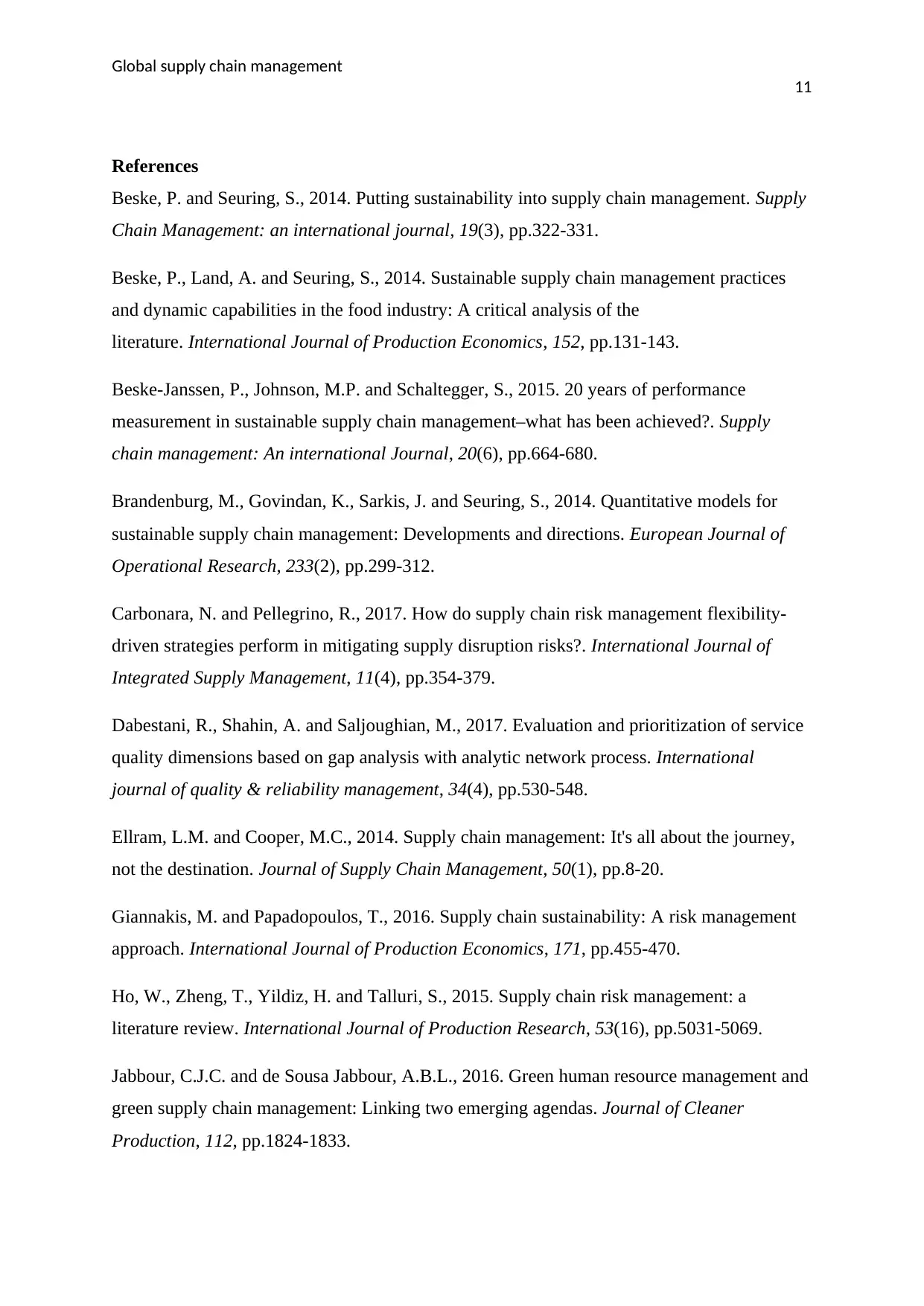
Global supply chain management
11
References
Beske, P. and Seuring, S., 2014. Putting sustainability into supply chain management. Supply
Chain Management: an international journal, 19(3), pp.322-331.
Beske, P., Land, A. and Seuring, S., 2014. Sustainable supply chain management practices
and dynamic capabilities in the food industry: A critical analysis of the
literature. International Journal of Production Economics, 152, pp.131-143.
Beske-Janssen, P., Johnson, M.P. and Schaltegger, S., 2015. 20 years of performance
measurement in sustainable supply chain management–what has been achieved?. Supply
chain management: An international Journal, 20(6), pp.664-680.
Brandenburg, M., Govindan, K., Sarkis, J. and Seuring, S., 2014. Quantitative models for
sustainable supply chain management: Developments and directions. European Journal of
Operational Research, 233(2), pp.299-312.
Carbonara, N. and Pellegrino, R., 2017. How do supply chain risk management flexibility-
driven strategies perform in mitigating supply disruption risks?. International Journal of
Integrated Supply Management, 11(4), pp.354-379.
Dabestani, R., Shahin, A. and Saljoughian, M., 2017. Evaluation and prioritization of service
quality dimensions based on gap analysis with analytic network process. International
journal of quality & reliability management, 34(4), pp.530-548.
Ellram, L.M. and Cooper, M.C., 2014. Supply chain management: It's all about the journey,
not the destination. Journal of Supply Chain Management, 50(1), pp.8-20.
Giannakis, M. and Papadopoulos, T., 2016. Supply chain sustainability: A risk management
approach. International Journal of Production Economics, 171, pp.455-470.
Ho, W., Zheng, T., Yildiz, H. and Talluri, S., 2015. Supply chain risk management: a
literature review. International Journal of Production Research, 53(16), pp.5031-5069.
Jabbour, C.J.C. and de Sousa Jabbour, A.B.L., 2016. Green human resource management and
green supply chain management: Linking two emerging agendas. Journal of Cleaner
Production, 112, pp.1824-1833.
11
References
Beske, P. and Seuring, S., 2014. Putting sustainability into supply chain management. Supply
Chain Management: an international journal, 19(3), pp.322-331.
Beske, P., Land, A. and Seuring, S., 2014. Sustainable supply chain management practices
and dynamic capabilities in the food industry: A critical analysis of the
literature. International Journal of Production Economics, 152, pp.131-143.
Beske-Janssen, P., Johnson, M.P. and Schaltegger, S., 2015. 20 years of performance
measurement in sustainable supply chain management–what has been achieved?. Supply
chain management: An international Journal, 20(6), pp.664-680.
Brandenburg, M., Govindan, K., Sarkis, J. and Seuring, S., 2014. Quantitative models for
sustainable supply chain management: Developments and directions. European Journal of
Operational Research, 233(2), pp.299-312.
Carbonara, N. and Pellegrino, R., 2017. How do supply chain risk management flexibility-
driven strategies perform in mitigating supply disruption risks?. International Journal of
Integrated Supply Management, 11(4), pp.354-379.
Dabestani, R., Shahin, A. and Saljoughian, M., 2017. Evaluation and prioritization of service
quality dimensions based on gap analysis with analytic network process. International
journal of quality & reliability management, 34(4), pp.530-548.
Ellram, L.M. and Cooper, M.C., 2014. Supply chain management: It's all about the journey,
not the destination. Journal of Supply Chain Management, 50(1), pp.8-20.
Giannakis, M. and Papadopoulos, T., 2016. Supply chain sustainability: A risk management
approach. International Journal of Production Economics, 171, pp.455-470.
Ho, W., Zheng, T., Yildiz, H. and Talluri, S., 2015. Supply chain risk management: a
literature review. International Journal of Production Research, 53(16), pp.5031-5069.
Jabbour, C.J.C. and de Sousa Jabbour, A.B.L., 2016. Green human resource management and
green supply chain management: Linking two emerging agendas. Journal of Cleaner
Production, 112, pp.1824-1833.
⊘ This is a preview!⊘
Do you want full access?
Subscribe today to unlock all pages.

Trusted by 1+ million students worldwide
1 out of 14
Related Documents
Your All-in-One AI-Powered Toolkit for Academic Success.
+13062052269
info@desklib.com
Available 24*7 on WhatsApp / Email
![[object Object]](/_next/static/media/star-bottom.7253800d.svg)
Unlock your academic potential
Copyright © 2020–2025 A2Z Services. All Rights Reserved. Developed and managed by ZUCOL.




